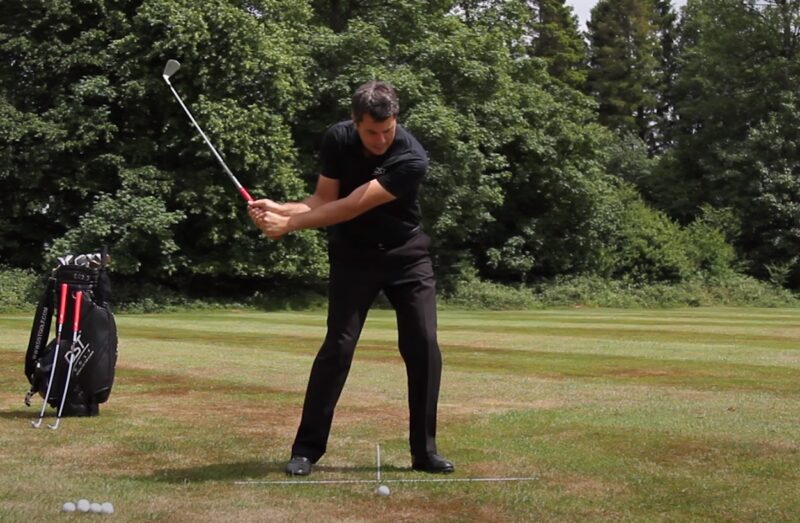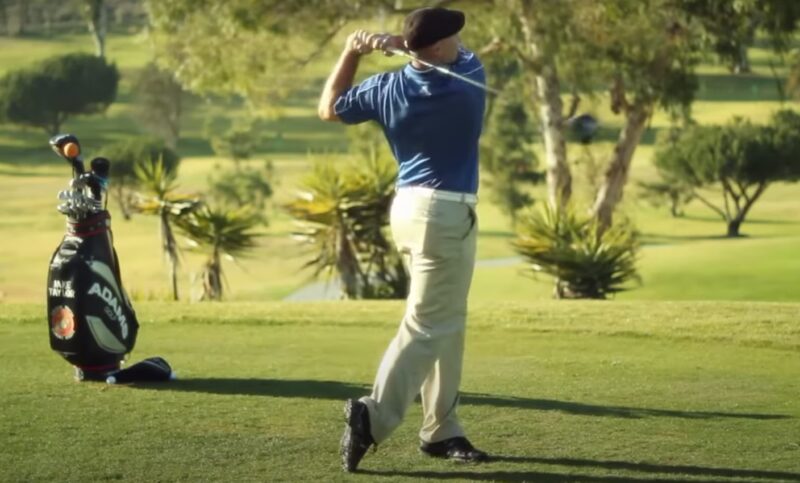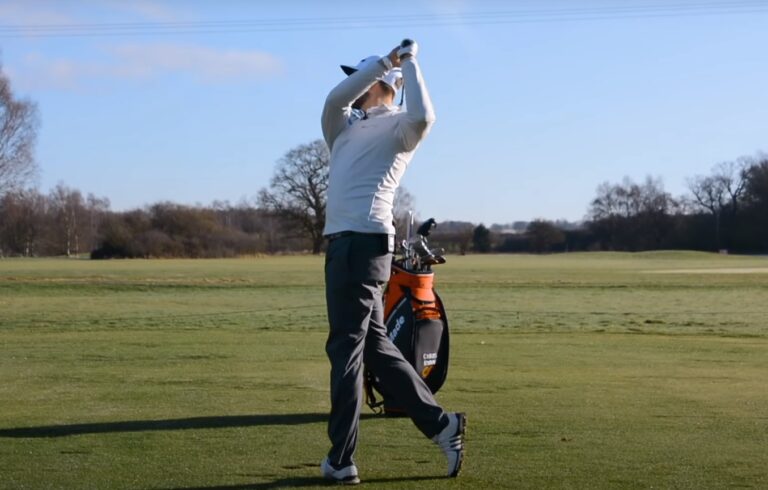Golf, a sport of precision, strategy, and technique, hinges significantly on the mastery of the golf swing. At the heart of a powerful and effective golf swing lies the pivot – a critical, yet often overlooked, component.
This article delves into the intricacies of pivoting in the golf swing, elucidating why it is paramount for golfers of all levels to understand and master this movement.
Key Takeaways
Pivot in Golf
The pivot in golf refers to the rotational movement of the body during the swing. This movement is not just a mere turning of the hips or shoulders but an orchestrated sequence of rotations that begins from the ground up.
The pivot involves the coordination of the feet, knees, hips, torso, and shoulders. It is the driving force that initiates the power and direction of the swing, setting the stage for the club’s path and the eventual impact with the ball.
The Role of the Lower Body
The foundation of a good pivot starts with the lower body. The feet, knees, and hips work in harmony to create a stable yet dynamic base. During the backswing, weight shifts to the inside of the back foot, and the back knee flexes while the front knee remains relatively stable. This movement allows the hips to turn while maintaining balance.
The degree of hip rotation varies among players but is essential for generating power. In the downswing, the process reverses, with the hips leading the movement towards the target, followed by the knees and feet. This sequence ensures a powerful transfer of energy from the lower body to the upper body.
Upper Body Dynamics

While the lower body initiates the pivot, the upper body completes it. The shoulders play a pivotal role in this phase. During the backswing, the shoulders rotate around the spine, creating a torque that is essential for power.
The torso and arms follow this rotation, setting the club on the correct path. The downswing sees the shoulders unwinding, releasing the stored energy into the swing. It is crucial to maintain a consistent spine angle throughout this process to ensure a stable and effective swing.
| Technique | Description | Purpose/Effect |
|---|---|---|
| Shoulder Rotation | During the backswing, rotate the shoulders around the spine, allowing the lead shoulder to move under the chin. | Generates torque for power and sets the stage for a proper downswing. |
| Torso Alignment | Keep the torso aligned with the spine, ensuring that it follows the shoulder rotation without excessive bending or leaning. | Maintains balance and promotes a consistent swing path. |
| Arm Coordination | Let the arms follow the torso’s rotation, keeping them relaxed but controlled, especially during the transition from backswing to downswing. | Ensures that the club moves on the correct path and maintains rhythm in the swing. |
| Maintaining Spine Angle | Keep a consistent spine angle throughout the swing, especially during the shoulder and torso rotation. | Prevents mis-hits and inconsistency in the swing due to changes in the body’s orientation to the ball. |
| Controlled Shoulder Unwinding | Start the downswing with a controlled unwinding of the shoulders, allowing the lower body to lead while the upper body follows in a synchronized manner. | Facilitates a smooth release of stored energy, contributing to swing power and accuracy. |
| Upper Body Flexibility | Regularly engage in flexibility exercises focusing on the shoulders and torso to enhance the range of motion and reduce the risk of injuries. | Increases the effectiveness of the pivot, allowing for a fuller swing and greater power generation. |
| Rhythm and Timing | Focus on a smooth, rhythmic movement where the backswing is deliberate and the downswing is executed with a seamless transition between the upper and lower body. | Ensures a harmonious swing with proper energy transfer, essential for achieving distance and accuracy. |
The Importance of the Spine Angle
The spine angle is a critical aspect of a successful pivot. Maintaining a consistent spine angle throughout the swing ensures that the clubhead follows the intended path. Changes in the spine angle can lead to a variety of swing faults, such as slices or hooks.
A stable spine angle also allows for a more efficient transfer of energy from the body to the club, maximizing power and control.
Timing and Rhythm
The effectiveness of a pivot is not just in its mechanics but also in its timing and rhythm. A well-timed pivot ensures that the various components of the swing work in sync, creating a smooth and powerful motion. The backswing should be a deliberate and controlled movement, allowing time for the proper rotation and torque build-up.
The transition to the downswing should be fluid, with the lower body leading and the upper body following in a seamless sequence. The rhythm of the swing is equally important, as it helps maintain balance and consistency.
Common Mistakes and Corrections

Many golfers struggle with the pivot, often leading to inefficient and inconsistent swings. Common mistakes include over-rotating the hips, swaying instead of turning, and losing the spine angle.
To correct these faults, golfers can practice drills that emphasize the proper pivot mechanics, such as hip-turn exercises and shoulder rotation drills. Video analysis and professional instruction can also provide valuable feedback and guidance.
FAQs
How does foot positioning affect the pivot in a golf swing?
Foot positioning is crucial in the pivot as it affects balance and stability. Your feet should be shoulder-width apart, with the back foot perpendicular to the target line and the front foot slightly flared towards the target.
This positioning allows for a full hip turn in the backswing and a stable base for the downswing, facilitating a more powerful and controlled pivot.
Can the pivot technique vary based on different types of golf shots?
Yes, the pivot can vary depending on the shot. For instance, a full swing requires a more pronounced pivot with significant rotation of the hips and shoulders.
In contrast, shorter shots like pitches or chips require a more subdued pivot, focusing more on the arms and less on lower body rotation to maintain control and accuracy.
What is the role of the arms in the pivot?
The arms are primarily responsible for maintaining the connection with the body during the pivot. They should move in sync with the upper body rotation, ensuring that the club follows the correct path.
Overactive arms can disrupt the swing’s rhythm and lead to inconsistencies, so it’s important to let the body’s rotation guide their movement.
How do I know if I’m pivoting correctly in my golf swing?
A correct pivot can be identified by a smooth, controlled rotation of the body and a balanced finish. You should feel a natural flow of movement from the feet to the shoulders, with no abrupt jerks or pauses.
Is flexibility important for a good pivot, and how can I improve it?
Yes, flexibility plays a significant role in achieving an effective pivot. Greater flexibility allows for a fuller range of motion, which is essential for generating power and maintaining proper form.
To improve flexibility, regularly engage in stretching exercises that focus on the hips, back, and shoulders, as these areas are crucial for the pivot.
What is the best way to practice and improve my pivot?
The best way to practice and improve your pivot is through repetition and drills. Focus on isolating the pivot movement in your practice, perhaps using a mirror or video recording to analyze your technique. Drills that emphasize hip rotation and shoulder turn can be particularly effective. Additionally, consider working with a golf instructor who can provide personalized feedback and guidance.
Final Words
The pivot is a fundamental aspect of the golf swing, integral to generating power, accuracy, and consistency. By understanding and mastering the mechanics of the pivot, golfers can significantly improve their game. It requires a harmonious blend of lower and upper body movements, a stable spine angle, and precise timing and rhythm.
Like any skill in golf, the pivot requires practice and patience, but the rewards are well worth the effort. A well-executed pivot can transform a golfer’s swing, leading to more enjoyable and successful rounds on the course.

